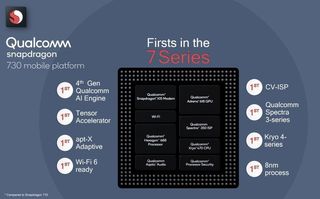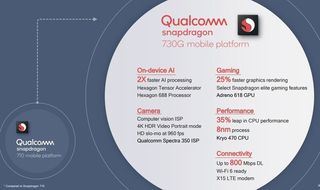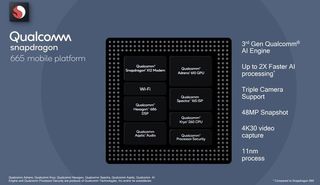Qualcomm's Snapdragon 665, 730, and 730G bring flagship features to the mid-range category

Qualcomm has dominated the mid-range segment in recent years thanks to the strong performance of the Snapdragon 6xx and 7xx series, and the chip vendor is making key updates in this category for 2019. The Snapdragon 665 will take over from the Snapdragon 636 and 660, and the mid-range is getting two new additions in the 7xx series: the Snapdragon 730 and 730G.
All three chipsets sport considerable upgrades in terms of performance and AI capabilities, and Qualcomm is also adding support for 5x optical zoom as standard. The Snapdragon 730 and 730G in particular are intriguing as they bring several flagship-tier features for the first time to the 7xx series, including Vulkan 1.1 graphics, Wi-Fi 6, HDR gaming, fourth-generation AI engine, and Spectra 350 ISP.
Qualcomm is looking to continue the momentum in the sub-$500 category with the new chipsets, and while we haven't seen much in the way of devices based on the Snapdragon 7xx series in the U.S., Qualcomm has confirmed that a device with a 7-series chipset will debut in the country "imminently."
In addition to the new chipsets, Qualcomm is debuting Cloud AI 100, a new solution for AI inference processing in the cloud.
Snapdragon 730/730G — HDR gaming and 4th-gen AI engine

The Snapdragon 730 and 730G are designed to offer flagship-tier performance in the mid-range segment. We've already seen this with the Snapdragon 710 in the likes of the Nokia 8.1, and the 730/730G deliver considerable uptick in performance from last year's platform and bring Qualcomm's latest technologies to this category.
First up is the AI engine: both the Snapdragon 730 and 730G sport Qualcomm's fourth-generation AI engine, with Tensor accelerator cores that provide a 2x boost in AI-related tasks when seen against the 710. Both chipsets also support Wi-Fi 6 with 2x2 MU-MIMO, X15 LTE modems that offer up to 800Mbps download speeds, Dual SIM Dual VoLTE, as well as VoWiFi.
The new chipsets enable higher-res displays, Quick Charge 4.0+, 8GB RAM, and camera sensors up to 192MP.
The Snapdragon 730 supports displays up to 2520 x 1080, with the 730G compatible with QHD+ (3360 x 1440) resolutions. Both chipsets support Vulkan 1.1 graphics and feature Qualcomm's audio-related aptX Adaptive and Aqstic codecs to deliver an immersive audio experience. The new chipsets are also compatible with Quick Charge 4.0+, Bluetooth 5.0, and up to 8GB of LPDDR4 RAM at 1866MHz.
Be an expert in 5 minutes
Get the latest news from Android Central, your trusted companion in the world of Android
Another new addition is the Spectra 350 image signal processor, which offers better depth sensing, support for triple cameras — ultra-wide, portrait and telephoto lenses — and the ability to capture photos and videos in HEIF.

The Snapdragon 730 and 730G support single 48MP camera sensors with multi frame noise reduction, or up to 36MP with zero shutter lag. Similarly, dual cameras up to 22MP are supported, and the platforms also have compatibility with sensors that go up to 192MP in snapshot mode. When it comes to video, you get 4K at 30fps with HDR10, 1080p at up to 120fps, 720p at 240fps, and the ability to shoot 4K HDR portrait mode video with bokeh. The 730G also allows 720p at 960fps.
The Snapdragon 730 and 730G will turbocharge mid-range phones in 2019.
The platforms are fabricated on TSMC's 8nm node, and are powered by Kryo 470 cores and Adreno 618 — another first in the 7xx series. Qualcomm is sticking to a 2+6 design, with two high-performance 2.20GHz cores based on the Cortex A76 joined by six 1.80GHz energy-efficient cores based on the Cortex A55 platform.
Qualcomm is touting a huge 35% uptick in CPU performance from the Snapdragon 710, and 25% increase in visuals performance thanks to the Adreno 618 GPU. And with the Snapdragon 730G aimed at a gaming audience, it has an overclocked Adreno 618 GPU that delivers 15% better performance over and above what you get on the Snapdragon 730.

Another differentiator for the Snapdragon 730G is HDR gaming that will deliver "extreme realism with rich graphics and cinema-quality processing with over 1 billion shades of color." Qualcomm also says its in-house game studio collaborated with leading game publishers to optimize best-selling titles for the Snapdragon 730G platform, and that its Jank Reducer feature will remove jitter by up to 90%.
All in all, the Snapdragon 730 and 730G offer a slew of exciting features in the mid-range segment, and it'll be interesting to see how close the real-world performance is to the flagship Snapdragon 855.
Snapdragon 665 — budget devices are about to get much better

The Snapdragon 665 also has several upgrades over its predecessor. It has a third-generation AI engine that's twice as fast as the one on the Snapdragon 660, and the Spectra 165 ISP introduces AI-assisted camera features. Like the Snapdragon 730/730G, the 665 supports Vulkan 1.1 and aptX Adaptive and Aqstic codecs.
There's support for dual cameras up to 16MP, single 25MP cameras with zero shutter lag, and 48MP sensors in snapshot mode. The chipset is compatible with three camera configurations, and offers 4K video at 30fps and 720p at 240fps. Other features include Wi-Fi ac with MU-MIMO, FHD+ display support (2520x1080), Quick Charge 3.0, X12 LTE modem with 600Mbps download speeds, Dual SIM Dual Standby, VoWiFi, and up to 8GB of RAM.
The Snapdragon 665 is built on a 11nm node, and it has octa-core Kryo 260 cores that go up to 2.2GHz as well as an Adreno 610 GPU.
Bringing AI to the cloud

Alongside the new chipsets, Qualcomm is debuting a Cloud AI 100 solution that facilitates "distributed intelligence from the cloud to the client edge and all points in between." Qualcomm says the Cloud AI 100 offers a 10x performance boost over the most advanced AI inference solutions in the market today, with the 7nm chip also bringing power savings.
It works with the leading software stacks in the industry — including PyTorch, Glow, TensorFlow, Keras, and ONNX — and is slated to make its way to the market in the latter half of the year.
As for the new mobile chipsets, the Snapdragon 665 will be aimed at devices that cost between $200 to $300, with the Snapdragon 730 and 730G targeting the $300 to $450 segments. Qualcomm says the new platforms are commercially ready, and that the first wave of devices based on the new chipsets will be rolling out in mid-2019.

Harish Jonnalagadda is a Senior Editor overseeing Asia at Android Central. He leads the site's coverage of Chinese phone brands, contributing to reviews, features, and buying guides. He also writes about storage servers, audio products, and the semiconductor industry. Contact him on Twitter at @chunkynerd.
